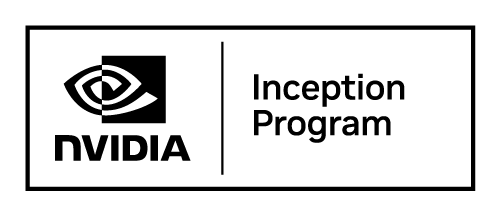Hiring today doesn't happen in one office or one time zone. It's messy, asynchronous, and often overloaded with applications. The best video interview software now doubles as video screening software that lets candidates record responses on their schedule, eliminating endless back-and-forth coordination.
Modern digital interview software doesn't just collect responses. These platforms generate tailored questions, analyze answers with AI, and surface the candidates worth a closer look. It's about making better hiring decisions, faster.
We tested more than 30 video interviewing platforms, ran mock hiring flows, and spoke with recruiters across industries. These nine virtual interview software solutions stood out.
What is video interview software?
Video interview software is a hiring tool that allows recruiters to screen candidates using recorded or live video responses. This interviewing software streamlines early-stage candidate evaluation, reduces scheduling overhead, and provides deeper insight than résumés alone.
The best video interviewing solutions offer both one-way (asynchronous) and live formats, AI analysis capabilities, and integrations with ATS platforms to help teams hire faster and more fairly. Unlike general video conferencing tools like Zoom, dedicated video screening software is purpose-built for recruitment with features like:
- Structured question templates
- Candidate evaluation and scoring tools
- Automated ranking and shortlisting
- Multi-reviewer collaboration
Modern digital interview platforms have evolved significantly since their introduction in the early 2010s. Today's virtual interview software incorporates advanced AI analysis, multi-language support, and accessibility features to create inclusive hiring experiences for global teams.
The 9 best video interview solutions
Compare nine leading video interviewing solutions—including the top asynchronous video interview platforms and video screening software—to slash screening time and improve candidate experience:
Best video screening software for high-volume hiring
If your primary need is video screening software for high-volume candidate evaluation, here's how the top platforms compare for screening efficiency:
Video screening software helps recruiters evaluate candidates at scale before investing time in live interviews. Unlike general video conferencing tools, dedicated screening platforms offer:
- One-way recording with structured, consistent questions
- AI-powered response analysis that highlights key insights
- Automated candidate ranking based on configurable criteria
- Bulk invite capabilities for high-volume roles
Bottom line: For pure video screening, Truffle and Willo offer the fastest path from application to shortlist. If you need both screening and live interviews, Spark Hire provides the best combination.
Digital interview platforms: The modern hiring standard
Digital interview software has replaced phone screens for most recruiting teams. These platforms combine asynchronous recording for initial screening with live video capabilities for final-round conversations—all in one system.
What makes digital interview platforms different from basic video calls:
- Asynchronous recording for initial candidate screening at scale
- Live video interviews for real-time final-round conversations
- AI analysis for consistent, unbiased evaluation
- ATS integration for seamless workflow automation
- Structured scoring rubrics for fair comparison
Whether you call it digital interview software, video interviewing platforms, or virtual hiring tools, the core functionality is similar. The key difference between solutions is how well each platform handles your specific hiring volume and process complexity.
Virtual interview software: Live vs. asynchronous
Modern virtual interview software typically supports two interview formats:
Asynchronous (one-way) video interviews:
- Candidates record responses on their own schedule
- Recruiters review at their convenience
- Best for: High-volume initial screening, global hiring across time zones
- Tools: Truffle, Willo, Hireflix
Live video Interviews:
- Real-time conversation between candidate and interviewer
- Allows for follow-up questions and rapport building
- Best for: Final rounds, senior roles, culture fit assessment
- Tools: HireVue, Spark Hire, VidCruiter
Hybrid Approach: Most teams use asynchronous video screening software for initial candidate filtering, then live interviews for shortlisted candidates. Platforms like Spark Hire and HireVue support both formats natively.
Best video interview software by use case
Not every platform fits every team. Here's which video screening software wins for your situation:
Best for startups and lean teams
Winner: Truffle – $99-129/month with AI summaries, no enterprise complexity, 10-minute setup.
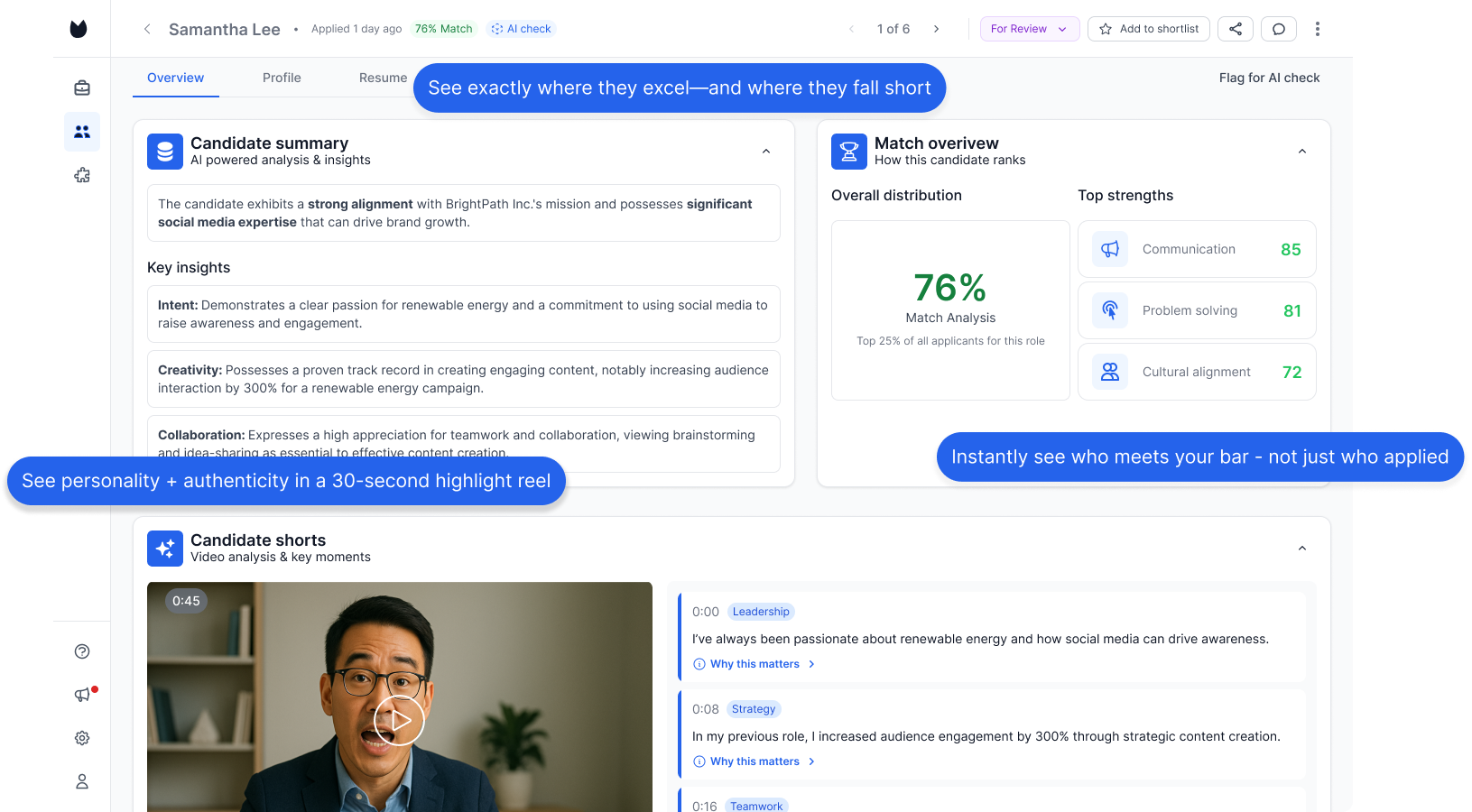
Best for SMBs needing live interviews
Winner: Spark Hire – From $299/month with one-way and live interview capabilities
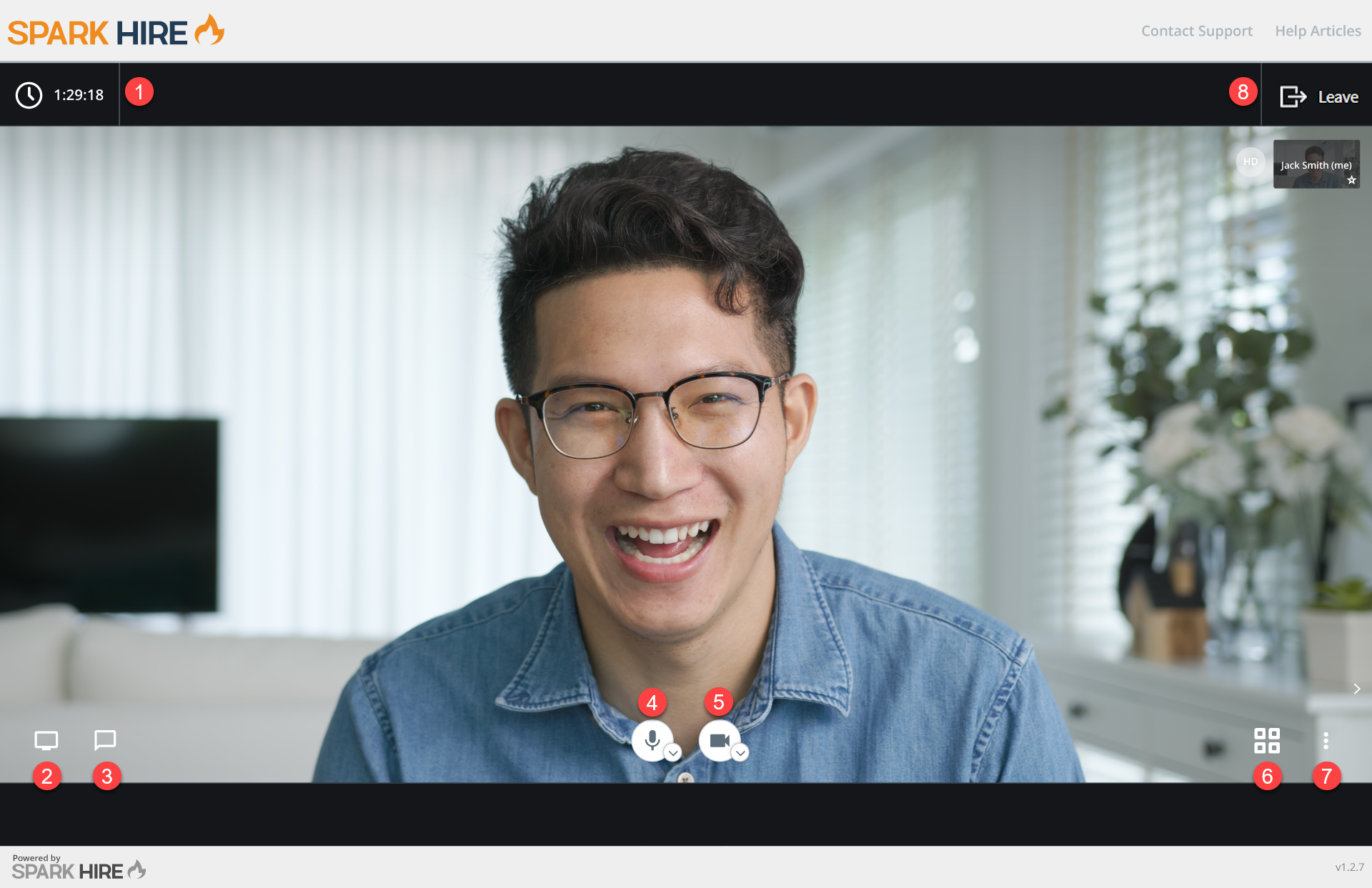
Best for Multi-Language Hiring
Winner: Willo – Supports 20+ languages for global async screening
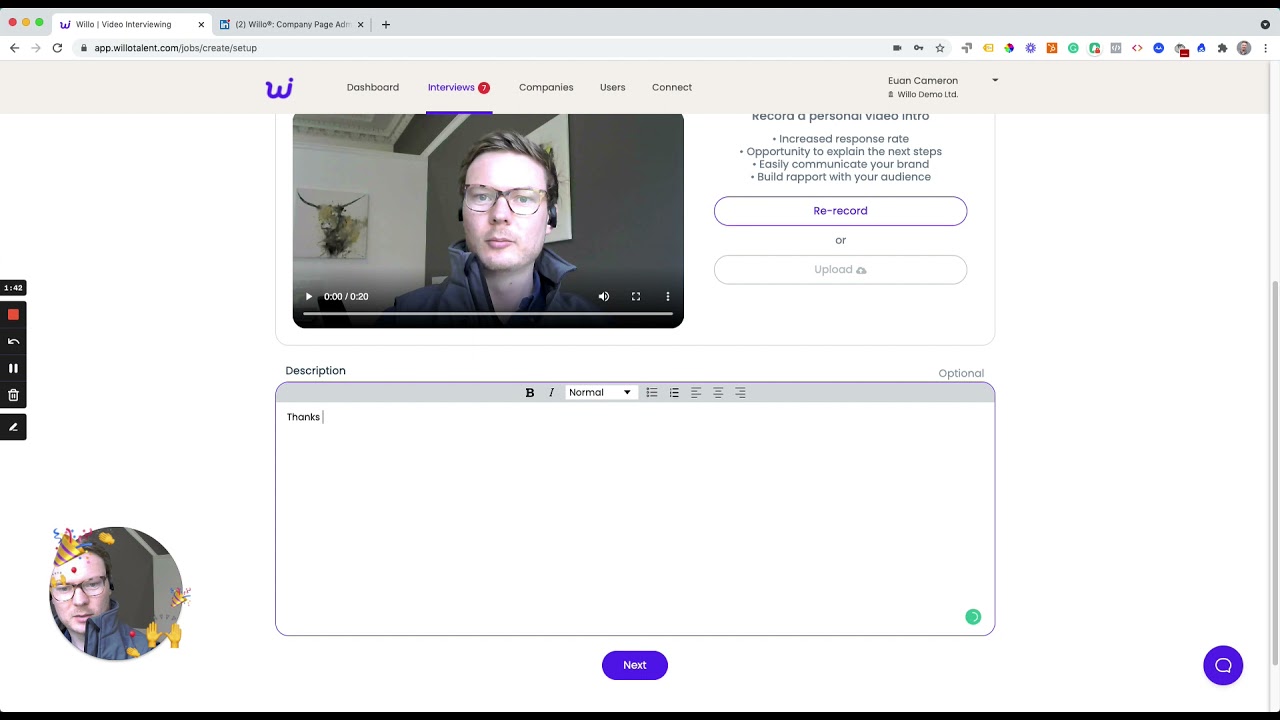
Best for enterprise & compliance
Winner: VidCruiter – SOC 2, ISO 27001, GDPR certified for regulated industries
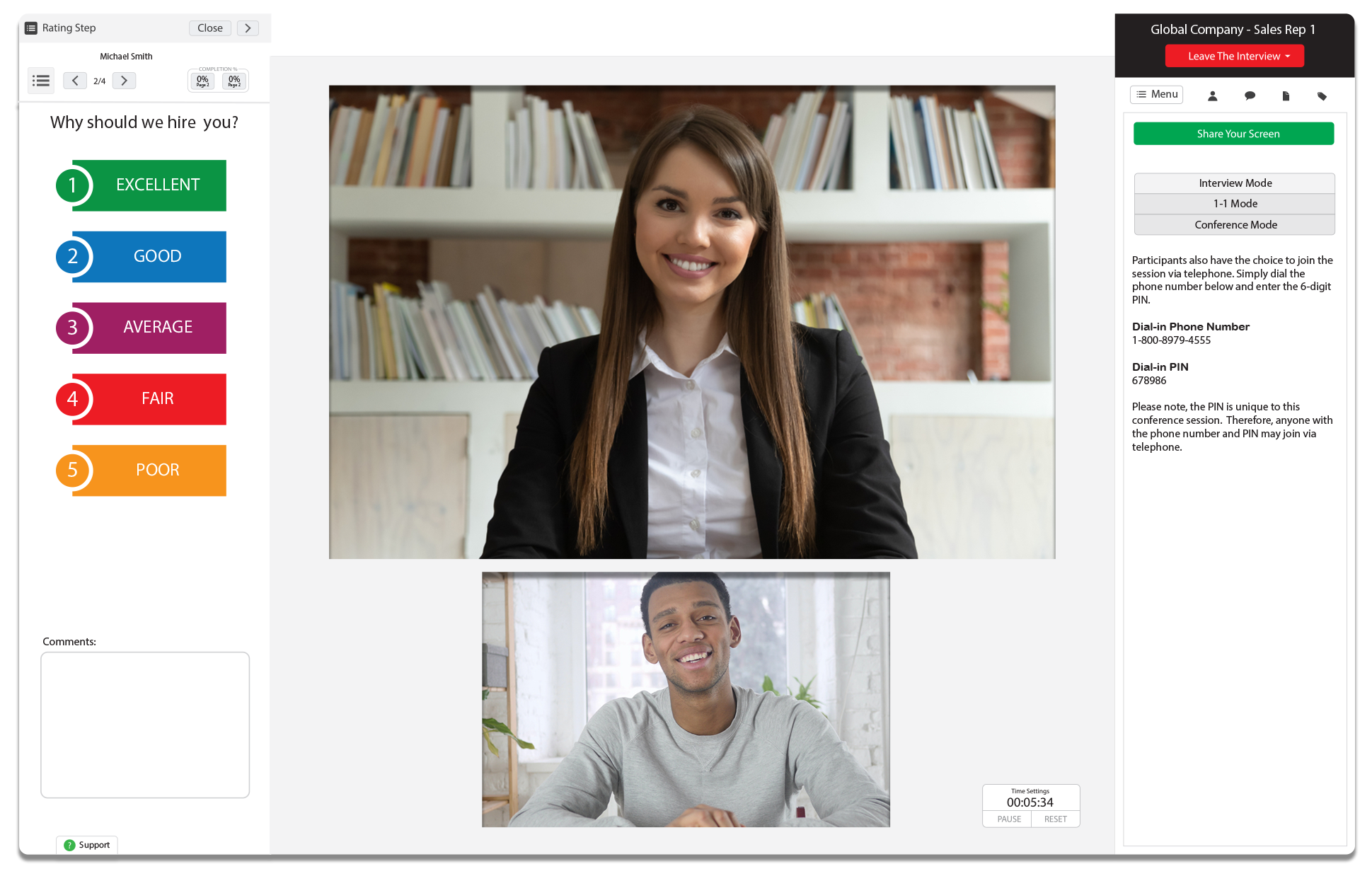
Best for campus recruiting
Winner: interviewstream – Bulk scheduling and university career center integrations
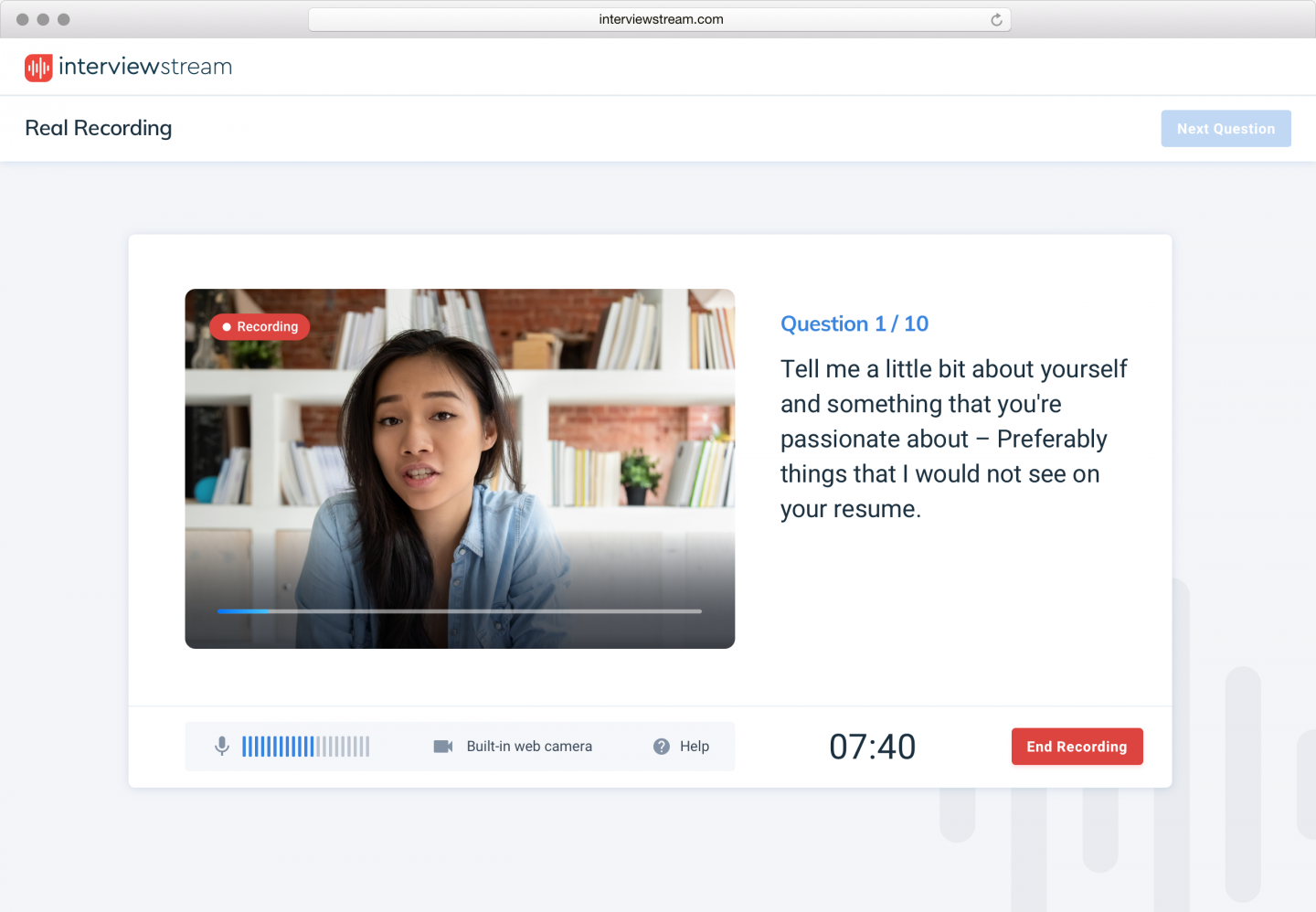
Best budget option
Winner: Hireflix – $75/month when paid annually for one-way video interviews

Best for enterprises
Winner: HireVue – Advanced AI scoring, game-based assessments, enterprise analytics

Video interview software pricing compared (2026)
Key insight: For small teams, Truffle offers the best value video interview software pricing—AI-powered video screening software at startup-friendly pricing without enterprise sales processes. Teams hiring at scale should consider Willo or Spark Hire. Enterprise organizations should budget $50K+ for full-featured digital interview platforms like HireVue.
Individual platform reviews
1. Truffle – Best one-way video interview software for small recruiting teams
If you're overwhelmed by Easy Apply applications and manual screening processes, Truffle is built specifically for small HR teams and founders at lean businesses. This one-way video interview software helps you quickly build ranked shortlists by automating high-volume candidate evaluation.
How it works: Begin with streamlined job setup—input role requirements, essential qualifications, and cultural priorities. Truffle generates structured interview questions and enables candidates to complete screenings on any device at their convenience.
The platform's AI candidate summaries and match analysis transcribe and evaluate every response, helping you quickly build ranked shortlists with manager-ready insights and quick-review transcripts.
Why recruiters love it: The mobile-optimized interface and candidate-focused experience means zero downloads required, flexible retake options, and under-10-minute setup. Truffle connects with existing workflows through API integrations—no enterprise complexity or sales processes required.
For lean businesses managing hundreds of applications per role without dedicated recruiting staff, this delivers the most effective video screening software solution.
Pricing: Free trial available; transparent monthly pricing from $99-129
Best for: Small HR teams and founders quickly building ranked shortlists from high-volume applications
Get started: hiretruffle.com
2. HireVue – Best for enterprise AI assessments
HireVue pioneered AI-driven video interviewing. Today, its digital interview platform blends asynchronous video interviews with game-based skill assessments and language tests.
The structured rating tools are especially helpful for reducing unconscious bias in large organizations. Real-time analytics and compliance dashboards make HireVue a safe pick for enterprises with legal and DEI requirements.
Trade-offs: The learning curve is steeper than SMB-focused video interview tools, and the pricing isn't public—industry sources suggest approximately $50,000+ annually.
Best for: Large enterprises and regulated industries
Notable features: Game-based testing, deep compliance, advanced AI scoring
Website: hirevue.com
3. Spark Hire – Best video interview software with an ATS add-on
Spark Hire is a popular choice for teams needing both one-way video screening software and live interview capabilities. It's affordable, intuitive, and used by over 6,000 companies.
Hiring teams can create interview templates, bulk-send invites, and review responses in less than half the time of traditional phone screens. The dashboard is simple to navigate, and support is responsive.
Key features: One-way and live interviews, ATS integrations, team collaboration tools, branded interview experiences
Pricing: From $299/month
Best for: SMBs and fast-moving recruiting teams needing flexible interviewing software
Website: sparkhire.com
4. VidCruiter – Best for compliance and data security
If your legal or procurement teams have strict requirements, VidCruiter delivers peace of mind. It's one of the few video interview platforms that's SOC 2 Type II, ISO 27001, FIPS, and GDPR certified.
Beyond strong data protections, VidCruiter offers automated rating guides, identity-verified interview flows, and custom workflows for complex hiring processes.
Trade-offs: The UI is less modern than competitors, but this is the digital interview software of choice for hospitals, government agencies, and universities.
Best for: Regulated sectors (healthcare, government, education)
Notable features: Industry-leading security certifications, audit trails
Website: vidcruiter.com
5. Willo – Best video interview software for multi-language hiring
Willo supports hiring across 20+ languages, making it a strong choice for global teams screening candidates in multiple regions. With async video interviews, candidates can record responses in their native language while recruiters review with built-in transcription and translation.
The clean UX and custom branding options work well for multinational organizations and BPOs with diverse candidate pools. Willo is async-only—there's no live interview option—so it's best suited for initial screening rather than full-funnel hiring.
Key features: 20+ language support, DEI analytics, anonymized candidate reviews, bulk screening, custom branding
Pricing: From $249/month
Best for: Global teams hiring across multiple languages and regions
Website: willo.video
6. myInterview – Best for early-stage teams
myInterview offers affordable asynchronous interviews, making it ideal for early-stage teams or startups just beginning with video screening.
Features include time-limited responses, candidate highlight reels, and basic AI keyword analysis. While it lacks advanced analytics, the UX is intuitive and integrations cover major ATS platforms.
Best for: Startups and lean teams on tight budgets
Pricing: Quote-based (contact for details)
Website: myinterview.com
7. interviewstream – Best for campus hiring
interviewstream is a full-cycle virtual interview software solution used by universities, campus recruiters, and healthcare organizations.
Its bulk scheduling tools, branded landing pages, and AI interview summaries make it ideal for managing large applicant cohorts from career fairs and campus events. It also includes live video options and structured evaluations.
Best for: Education and healthcare hiring, campus recruiting
Pricing: Quote-based (contact for details)
Website: interviewstream.com
8. Jobma – Best for budget-conscious teams
Jobma is one of the only pay-per-credit video interview platforms, making it a great fit for companies that hire infrequently or want to test video interviewing software without a monthly commitment.
It supports video, audio, text, and even coding questions—plus support for over 16 languages. The interface is basic but functional, and integrations cover most major ATS platforms.
Best for: Occasional hiring with limited budget
Pricing: Pay-per-credit model
Website: jobma.com
9. Hireflix – Best a simple one-way video interview experience
Hireflix is built for speed and simplicity. It focuses entirely on one-way video interviews, with no live interview option—and that's intentional.
Teams love the ability to create questions once and let candidates complete interviews asynchronously, anytime. It's a simple plug-in for teams already using Zoom or in-person interviews later in the funnel.
Best for: Streamlining early-stage screening with minimal complexity
Pricing: From $150/month
Website: hireflix.com
What makes the best video interview software?
Whether you're hiring your first employee or managing hundreds of applicants across multiple roles, video interview software has become essential. Phone screens are too slow, live Zoom calls don't scale, and résumés alone don't tell the full story.
Video interviewing solutions help you screen faster, go deeper, and offer candidates a better experience. But not all platforms are created equal. Here's what we looked for when evaluating the best video screening software:
Asynchronous and live interview options
The best video interview platforms offer both formats:
- Asynchronous (one-way): Candidates record responses at their convenience
- Live interviews: Real-time conversations for final-round discussions
- Hybrid models: Combine both formats for comprehensive screening
Integrating video interviews into your hiring process can save both time and resources. By allowing candidates to record responses to initial screening questions on their own schedule, recruiters reduce back-and-forth coordination and focus on reviewing the best matches.
AI and automation tools
Modern recruiting is fast-paced and repetitive. Good video screening software reduces manual work with features like:
- AI-generated questions tailored to specific roles
- Automatic scoring and sentiment analysis
- Structured summaries and candidate rankings
- Multi-language transcription and analysis
- Bias detection and mitigation tools
These features help hiring teams prioritize the right candidates without spending hours reviewing footage.
Candidate experience and accessibility
Great candidates ghost bad UX. The top interviewing software makes it easy for applicants to:
- Record from any device without downloads
- Skip account creation for faster access
- Re-record answers when needed
- Complete interviews at their convenience
- Access interviews in multiple languages
- Use assistive technologies (screen readers, keyboard navigation)
Features like mobile optimization, WCAG 2.1 compliance, and fast-loading video playback all contribute to inclusive hiring experiences.
Security and compliance
Video interviews often collect personal data and biometric information, making compliance critical. We prioritized digital interview platforms that offer:
- SOC 2 Type II certification: Ensures secure data handling
- GDPR compliance: Protects EU candidate privacy rights
- ISO 27001 certification: International security standards
- Data encryption: Both in transit and at rest
- Candidate consent management: Clear privacy controls
- Data retention policies: Automatic deletion after specified periods
Integrations and recruiting automation
Your video interview solution shouldn't live in a silo. The best platforms integrate natively with:
- ATS tools: Greenhouse, Lever, Workable, BambooHR
- Calendar systems: Google Calendar, Outlook, Calendly
- Communication tools: Slack, Microsoft Teams, Gmail
- Automation platforms: Zapier, Make, custom APIs
This ensures interviews trigger the right workflows, from scheduling to scoring to feedback collection. For more options, see our guide to recruitment assessment tools.
Bias mitigation and structured evaluation
If your team is serious about fair hiring, structure matters. Look for virtual interview software that supports:
- Consistent scoring rubrics across all candidates
- Anonymized review modes to reduce unconscious bias
- Audit-friendly logs for compliance tracking
- Standardized question sets for role consistency
- DEI analytics and reporting
ROI and benefits of video interview software
Organizations implementing video screening software typically see:
- 50-70% reduction in time-to-hire: Faster screening and scheduling
- 60% cost savings: Reduced travel and coordination expenses
- 3x more candidates evaluated: Asynchronous format increases capacity
- 40% improvement in candidate experience: Flexible scheduling and mobile access
- 25% increase in diversity: Broader reach and bias reduction tools
These metrics demonstrate clear business value, especially for high-volume hiring scenarios. Learn more about remote interview tools that complement video interviewing platforms.
6 steps to structure your video interview
Here's how to structure your video interviews.
1. Define your purpose
Decide if you're screening for culture fit, technical skills, communication ability, or specific qualifications.
2. Craft clear questions
Use behavioral prompts ("Describe a time you solved a problem under pressure"), situational scenarios ("How would you handle X situation?"), or technical questions. Avoid yes/no questions or vague language.
3. Set time limits
- Basic questions: 1-1.5 minutes
- Behavioral/situational: 2-3 minutes
- Technical explanations: Up to 4 minutes
4. Provide clear instructions
Include technical requirements, total duration (typically 10-20 minutes), submission deadline, and support contact information.
5. Include a practice question
Let candidates test their setup with a non-scored warm-up question like "Describe a hobby you enjoy."
6. Create a scoring rubric
Use consistent criteria (clarity, relevance, job knowledge, communication) with a 1-4 scale. Have multiple reviewers score independently to reduce bias.
Evaluation best practices
- Review submissions within 5-7 business days and communicate timelines upfront
- Use the same rubric across all reviewers and train them on consistent scoring
- Offer alternatives (phone screen, mobile recording, extended deadlines) for candidates with technology limitations
- Store recordings securely with encryption and defined retention policies
When implemented well, one-way interviews streamline early screening while maintaining—or even improving—consistency and fairness in your hiring process.
Final thoughts on choosing your video interviewing solution
The best video interview software fits your hiring volume, process complexity, and candidate expectations.
Quick recommendations:
- For small HR teams quickly building ranked shortlists → Truffle
- For SMBs needing live and async interviews → Spark Hire
- For high-volume screening at scale → Willo
- For full-stack enterprise needs → HireVue
- For compliance-heavy hiring → VidCruiter
- For simple, budget-friendly screening → Hireflix
Most importantly, choose a digital interview platform that integrates with your ATS or hiring stack. That's what ensures your hiring process remains seamless—from application to offer.
For more comparisons, see our detailed reviews of VidCruiter pricing and features and Spark Hire vs Hireflix.
What's next in video interviewing software?
The next wave of video interviewing solutions will go beyond basic automation. Expect:
- Deepfake detection to verify candidate authenticity
- Voice stress analysis for additional screening signals
- Candidate-controlled privacy settings for data ownership
- Enhanced AI coaching to help candidates prepare
- Real-time translation for global hiring without language barriers
Companies that embrace structured video interviewing now will have a head start—not just in speed, but in fairness, data quality, and global reach. For related hiring technology, explore our guide to asynchronous interviews.
Frequently asked questions about video interview software
What is the best video interview software for small businesses?
For small businesses, we recommend Truffle ($99-129/mo) for AI-powered screening or Spark Hire (from $299/mo) if you need both one-way and live interviews. Both offer transparent pricing without enterprise sales processes.
What's the difference between video screening software and video interview platforms?
Video screening software focuses on one-way, asynchronous candidate recording for initial evaluation. Video interview platforms typically include both screening and live interview capabilities. Most modern solutions—like Truffle, Spark Hire, and Willo—offer both formats in a single platform.
Can I record job interviews with video interview software?
Yes. Most platforms automatically record video sessions, which helps you review candidate responses and share them with your team. Recordings also cut down on note-taking and let you compare applicants more consistently. Ensure you follow data protection rules and get consent from candidates before recording.
How long does it take to implement video interview software?
Implementation time varies significantly. Simple, standalone tools like Truffle or Hireflix can be up and running in a day. Enterprise platforms that require deep ATS or HRIS integrations might take anywhere from several days to a few weeks. Factor in user training and any custom workflows you'll need.
Can video interview software integrate with our existing HR or ATS tools?
Yes. Most top video interviewing platforms integrate natively or via API with popular ATS and HR systems like Greenhouse, Lever, Workable, and BambooHR. This streamlines scheduling, evaluation, and communication by keeping everything in one place.
How does digital interview software reduce hiring bias?
Digital interview software reduces bias through standardized questions, consistent scoring rubrics, and AI-powered evaluation that focuses on response content rather than appearance. Platforms like VidCruiter and Willo also offer anonymized review modes where reviewers evaluate responses without seeing candidate names or photos.
Are there free video interview platforms available?
Yes. Tools like Truffle offer free trials, and platforms like Zoom provide basic video capabilities at no cost. Free tiers typically have limitations—such as caps on the number of interviews or users—so they're best suited for small teams or short-term hiring needs.
How does video interview software support remote and global hiring?
Virtual interview software is designed for distributed teams. Asynchronous interviews let candidates respond anytime, while live options enable real-time conversations across time zones. This flexibility opens access to a broader, more diverse talent pool.
What are the pros and cons of asynchronous (one-way) video interviews?
Pros:
- Saves time by letting candidates record on their own schedule
- Creates a consistent, fair experience across all candidates
- Makes it easier to compare responses at scale
- Reduces scheduling coordination overhead
Cons:
- Can feel impersonal without real-time interaction
- Doesn't allow for follow-up questions
- May create a less engaging experience for some candidates
How can we ensure a fair evaluation process with video interviews?
Use standardized questions and scoring rubrics across all candidates. Train reviewers to spot and reduce bias. Some platforms offer anonymized reviews and audit trails to support fairness and consistency in decision-making. Regular calibration sessions between reviewers also help maintain evaluation consistency.
What equipment do I need to conduct a video interview?
You'll need a reliable internet connection, a camera, and a microphone (often built into a computer or phone) in a quiet, well-lit space. A high-definition webcam, noise-cancelling headphones, and an external mic can improve quality, but built-in laptop tools work well if you test them ahead of time.
Which video interview software has the best AI features?
For enterprise-level AI assessment, HireVue offers the most advanced capabilities including game-based testing and predictive analytics. For small teams wanting AI features at affordable pricing, Truffle provides AI-generated summaries, candidate ranking, and match analysis at a fraction of the cost.
Last updated: November 2025. We regularly test and update our video interview software recommendations. Have questions about choosing the right platform? Contact us.


